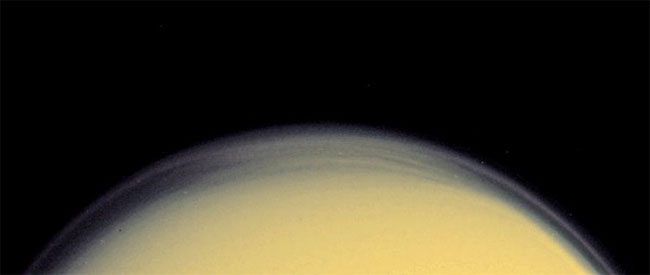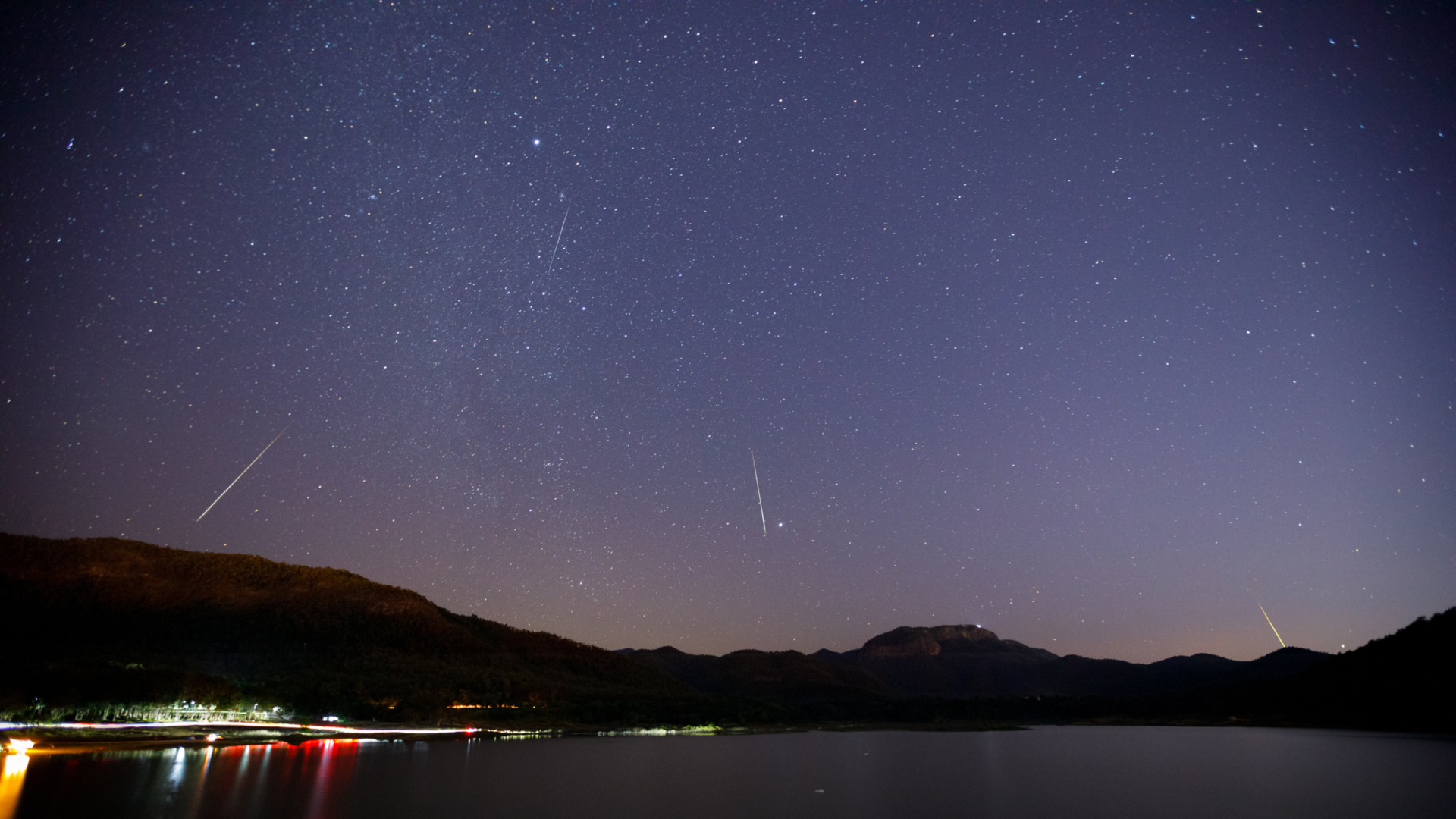Plunge Into an Alien World

Astronomers have wondered over Saturn's smog-shrouded moon Titan for decades. It is thought to be loaded with hydrocarbons -- like natural gas -- and other chemicals that are the sorts of things Nature uses to build life.
Theorists think Titan might be a lot like primitive Earth, just before life developed here.
But the moon's thick veil prevents all but fuzzy glimpses at its surface, made possibly only by peering at specific wavelengths outside the visible realm with complex instruments. Recent observations by the Cassini spacecraft -- including one that shows the haze is split into many layers -- have not solved any of the mysteries. Titan may be covered by hydrocarbon seas. It may have soaring mountains and plateaus of hydrocarbon ice. Or not.
On Jan. 14, our view of Titan should change forever, as the Cassini spacecraft's piggybacked Huygens probe parachutes through the smog and lands -- or splashes -- on the surface. Cassini will release the probe Dec. 25.
European astronomer Athena Coustenis has been trying to figure Titan out for years, and she's eagerly awaiting the Huygens pictures and data.
The interview with Coustenis below was conducted by Astrobiology Magazine, a web-based publication sponsored by the NASA astrobiology program. It is presented here in cooperation with the magazine.
-- SPACE.com Staff
Breaking space news, the latest updates on rocket launches, skywatching events and more!
When Cassini flew by Saturn's moon Titan on Oct. 26, scientists got a small taste of the discoveries to come. Astrobiology Magazine editor Leslie Mullen sat down with Athena Coustenis of the Paris-Meudon Observatory, and discussed a potential landscape of mountains and lakes on this strange, smog-filled world.
Astrobiology Magazine (AM): People thought for many years that Titan was completely covered by a hydrocarbon ocean. When did that change?
Athena Coustenis (AC): When I started out in this field in 1987, Jonathan Lunine's model of a global hydrocarbon ocean was like the bible to us. His model was published in 1983, and a global ocean was a very elegant explanation for why there was methane gas in Titan's atmosphere.
That outlook changed after observations of Titan were made in the near infrared. In that wavelength, there are what we call "methane windows," regions where you can pierce through Titan's thick smog and see all the way down to the surface.
The near infrared light curve of Titan's surface was not flat, which it would have been if the whole surface was covered with the same stuff, like an ocean. Since the surface was not homogeneous, that suggested that at least some part of Titan's surface was not liquid.
Then in the 1990s came the RADAR echoes, and these readings were more compatible with a solid surface. Adaptive optics images from the Keck Observatory, the CFH Telescope in Hawaii and the Very Large Telescope in Chile, as well as from the Hubble Space Telescope, showed a totally different surface than we had imagined.
The surface of Titan had these strange bright and dark patches.
AM: Do we know what these bright and dark patches are?
AC: Many people think the dark patches are hydrocarbon lakes, and the bright patches must be a solid material like ice.
I think the dark areas could be hydrocarbon lakes, because their albedo - their reflectivity - is very low. But I don't think all the dark patches have to be hydrocarbon liquid, because water ice also is dark at infrared wavelengths.
There are also intermediate regions where the bright and dark appear mixed. That could be slush, or mud, or something solid but with material in the pores. I like the idea of a porous surface, because even if the hydrocarbon lakes are there, they cannot account for the total amount of methane in the atmosphere. In my opinion, you're going to need a subsurface reservoir.
I think the bright patches are only consistent with hydrocarbon ice. They cannot be water ice, because water ice is dark in two of the wavelengths we're looking at. But hydrocarbon ice is bright in all the wavelengths.
So the bright regions could be plateaus or mountains with hydrocarbon ice on top. In order to get hydrocarbon ice, you have to have a mountain - a high elevation - and then the hydrocarbon can precipitate on top of that like snow.
AM: But so far, there's no evidence of mountains on Titan.
AC: No, but we've only looked at 0.4 percent of Titan's surface with Cassini. It would be like if someone was looking at Earth where there was a highway, and assumed the whole Earth is a highway! So we need to see more of Titan's surface.
The Huygens probe is going to land in an intermediate region, right between a dark and a bright patch. So maybe when it lands its going to look off to one side and see a mountain, and then on the other side will be a lake. It's going to be very interesting.
AM: The Huygens probe will probably tell us more about Titan's chemistry. How complex do you think that chemistry is?
AC: That's the big question. If you get larger and larger molecules, and more and more complex ones, then you're getting one step closer to the macromolecules of life.
AM: Like amino acids?
AC: Exactly. We have hydrogen cyanide (HCN) on Titan, and we know HCN is one of the building blocks that leads to molecules like amino acids. But have we reached that degree of complexity on Titan? Are there other nitriles there that are even more complicated? We're looking for them.
Personally, I think their abundance is still very small. I'm not a chemist, but I know that if the temperature is very low, you don't get the chemical reactions to behave the same way as on Earth.
On Titan, you have one-hundredth of the sunlight that reaches the Earth. And that sunlight mostly reaches the upper part of the atmosphere. The surface is even darker and colder, and chemical reactions aren't going to work as fast as they did on the early Earth. Maybe these reactions are occurring, but not enough complex molecules have been produced for us to be able to detect them.
The CIRS instrument on Cassini can detect large molecules, and it can detect a very low abundance. Cassini is going to be orbiting Saturn for four years, so we're hoping CIRS might detect some large molecules during that time.
AM: Are there any internal heat processes on Titan that might help drive those prebiotic chemical reactions?
AC: That's a good question. I don't think we know at this stage. But in order to produce a mountain, like the one I was telling you about, you would have to have some sort of cryovolcanism or tectonics - something to shift the crust around.
The surface of Titan looks young, because of the lack of impact craters that we've seen. So there may be some processes going on inside the moon that would explain any topography that we see.
- Tour Titan
- Cassini Special Report

Nobody knows whether the probe will hit a solid or liquid surface. The 700-pound (318-kilogram) probe will gather data all the way down, and it will report on Titan's surface for as brief as three minutes or as long as a half-hour, depending on the conditions it encounters.
More of Garlick's artwork can be viewed on his web site.

Space.com is the premier source of space exploration, innovation and astronomy news, chronicling (and celebrating) humanity's ongoing expansion across the final frontier. Originally founded in 1999, Space.com is, and always has been, the passion of writers and editors who are space fans and also trained journalists. Our current news team consists of Editor-in-Chief Tariq Malik; Editor Hanneke Weitering, Senior Space Writer Mike Wall; Senior Writer Meghan Bartels; Senior Writer Chelsea Gohd, Senior Writer Tereza Pultarova and Staff Writer Alexander Cox, focusing on e-commerce. Senior Producer Steve Spaleta oversees our space videos, with Diana Whitcroft as our Social Media Editor.
